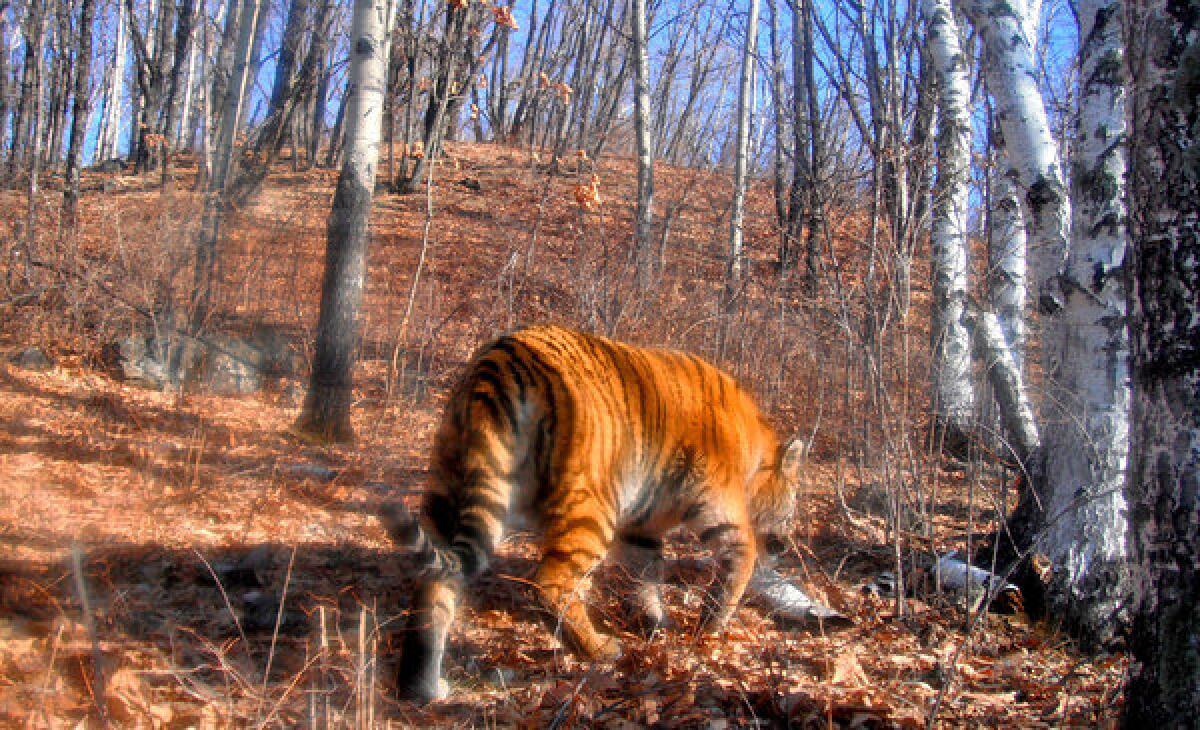Siberian tigers making a comeback in China

The Siberian tiger was once considered nearly extinct in China. Environmentalists praise the nation’s effort to restore habitat.
- Share via

In a lifetime of herding, Liu Xiangqing had never seen cows so scared.
Normally, at 6 a.m., they would be gathered together, contentedly chewing and grazing in the dawn light. But this June morning, they were scattered through the pine scrub, pacing with agitation, their ears alert. Liu took a quick head count and realized one was missing, a 2-year-old bull.
By the time the remains were located, the tail and thighs were missing, the entrails spilled in the dirt. There was a gash in the neck; claw marks raked down the torso.
It was a sure sign: The Siberian tiger was back.
"In my whole life, I'd never seen a real tiger, but I knew it couldn't be anything else," said the elfin-like Liu, 52, who grew up in this remote Chinese village wedged between the Russian and North Korean borders.
Once believed nearly extinct in China, the Siberian tiger, the largest member of the cat family, is making a comeback, the result of a decade-long effort to restore its natural habitat by banning logging, hunting and trapping.
Although they weigh as much as 675 pounds, Siberian tigers are elusive creatures that slink into the forest when humans approach. Villagers learn that a tiger has been on the prowl when they spot paw prints (or pug marks, as they are known) the diameter of melons. Or, as is happening more frequently in China, they discover that livestock is missing or mauled.
Four cows were killed in five days in May in another village near the border. One of the largest of Liu's herd, a 1,300-pound bull, lost his tail to a tiger but stayed alive by fighting back.
In March, a farmer investigating a noise pointed his flashlight into the darkness and saw a tiger with claws dug into a cow. He chased it away by banging a metal bucket and setting off a firecracker.
In China, the number of Siberian tigers living in the wild (far smaller than those in captivity) has been listed in government statistics at between 18 and 22 for some years, said Li Zhixing, who has worked for decades on tiger protection.
Nobody knows the exact number, because the Chinese don't have tracking collars on the tigers, but Li believes there could be as many as 40 now and that the population is growing.
"I personally think the number of tigers has doubled in the last decade and that the area populated by tigers has become much larger," said Li, 60.

Cattle rancher Liu Xiangqing's livestock have come under tiger attack in Jintang, China. One of the largest of Liu's herd, a 1,300-pound bull, lost his tail to a tiger but stayed alive by fighting back. (Tommy Yang / Los Angeles Times) More photos
Li credits campaigns to restore the degraded forests in China and Russia. The latter began tiger-protection efforts in the 1940s and has the largest population of Siberian tigers, between 400 and 900, according to the World Wildlife Fund.
But in recent years, China has caught up and might even be moving ahead in creating tiger-friendly habitat, Li said.
"Russia has fewer people than China, so it is a better place for tigers. But they are doing a lot of logging and burning off of agriculture fields after harvest, and the tigers don't like that," said Li, a native of Hunchun, the largest city in the region. "It is not hard for a tiger to jump over the barbed-wire fences at the border and come to China."
Although Chinese still buy illegal body parts of tigers — poached in India or killed in captivity — for traditional medicine, the wild tigers have not been hunted in China since the 1950s, Li said. In fact, hunting of all animals except rats is banned in China.
But many people in the down-at-the-heels villages near the Russian border trap other animals, which Li believes also has an effect on tigers. First of all, tigers can easily be snared in traps. More important, trapping sets off a destructive cycle of theft; if humans steal the deer and wild pigs that are the tigers' natural prey, the tigers in turn are prompted to steal the humans' livestock.
"Getting rid of the traps is absolutely critical to making a better environment for the tigers," said Li, who was making the rounds recently in the villages near the border, distributing beekeeping equipment to encourage an alternative livelihood to trapping.
The Chinese government also has sought to improve the public's attitude toward tigers by compensating farmers for pilfered livestock. Liu, for example, expects to receive about $500 for the young bull killed in June. Chinese newspapers now contain a multitude of articles about tiger attacks on farms, further raising awareness.

A worker with the World Wildlife Fund carries an injured sika deer that will serve as food for Siberian tigers in Lanjia forest near Wangqing county in China's Jilin province. (Wang Zhao / AFP/Getty Images) More photos
Here in Jilin province, the Forestry Ministry has designated a wildlife preserve containing 108,700 acres of spruce, pine and larch forest, the favorite habitat of the tiger. In August, scientists released 37 deer into the preserve to attract tigers as well as leopards, another endangered species native to the region.
"If you want to protect tigers, you have to protect their food supply," Zhang Changzhi, a scientist with the World Wildlife Fund, which is sponsoring the project, said as he toured a preserve in Wangqing county recently.
Heat-detecting cameras attached to trees attest to the success of the project; they have produced three photographs of leopards and one of a tiger.
Tigers are endangered throughout the world: Their population in the wild has dwindled from an estimated 100,000 in the early 20th century to as few as 3,200 today. Siberian tigers, also known as Amur or Korean tigers, are among six surviving subspecies and are native to the boreal forests, or taiga, of China, Russia and North Korea.
We are always in groups of two or three so there is somebody to scare off the tiger."— Qi Shuyan
Chinese efforts on behalf of the Siberian tiger have won worldwide praise among environmentalists.
A 2010 report in the journal of the Yale School of Forestry & Environmental Studies compared China's preservation efforts favorably with India's and ventured that China might even earn the right to claim it "saved the tiger."
Chinese have been amazed not only by the apparent growth of the tiger population but also by how far the felines have spread. It made headlines around China this year when tigers were seen near Jiamusi, a city 140 miles from the Russian border.
"My father used to tell how he once helped Russians hunt tigers, but in my lifetime — and I'm almost 50 — there hadn't been tigers around here until now," said Che Shiguo, a farmer from the outskirts of Jiamusi, in Heilongjiang province. He saw a tiger devouring a 3-month-old calf in August.

A tiger is caught on hidden camera in China's Jilin province. Heat-detecting cameras attached to trees also produced three photographs of leopards. (World Wildlife Fund / Wangqing County Forestry Bureau) More photos
He screamed, and the tiger ran away.
"If not, I would probably have been eaten by the tiger too," Che said.
The last time a tiger killed a human in China was 2002, and that was considered a freak incident, the result of an angry, wounded animal that had fallen into a trap. In 2006 and 2007, people were injured in tiger attacks near Hunchun, but both survived. Compared with some other subspecies, such as India's Bengal tigers, Siberian tigers are not considered dangerous to humans, preferring as they do to lurk quietly in the woods.
"We never go out into the mountains now alone. We are always in groups of two or three so there is somebody to scare off the tiger," said Qi Shuyan, 46, who works on the same ranch in Jintang as Liu Xiangqing.
Li, the tiger expert, says attacks are relatively rare here because of Chinese respect for the tiger, revered by many as a mountain god.
"There is a superstition here that a tiger will only attack you if you do something bad," Li said. "Sometimes when people encounter a tiger, they don't run, they just kneel and pray."
Tommy Yang of The Times' Beijing bureau contributed to this report.
Follow Barbara Demick (@BarbaraDemick) on Twitter
Follow @latgreatreads on Twitter
More great reads
The Cactus Curtain splits Lancaster and Palmdale
Back then we fought all the time. But it was a friendlier fight."
L.A.'s numero uno radio host stays humble

Sign up for Essential California
The most important California stories and recommendations in your inbox every morning.
You may occasionally receive promotional content from the Los Angeles Times.








